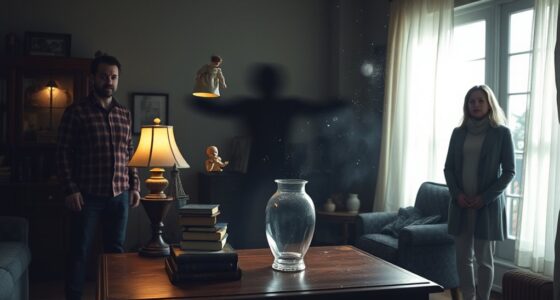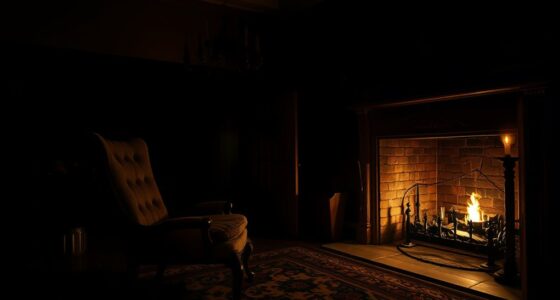Unexplained scratches at a vintage theater often result from physical wear, environmental stress, or accidental damage, challenging preservation efforts. Restorers must balance maintaining historic integrity with effective repairs, using gentle cleaning and compatible filling materials. Deeper scratches may signal underlying issues like material fatigue or structural stress, requiring careful evaluation. Ongoing monitoring and preventive care are key to safeguarding the theater’s charm for future generations. To understand the complexities involved, keep exploring the measures for long-term preservation success.
Key Takeaways
- The scratches may result from environmental stressors, material aging, or accidental damage, complicating restoration efforts.
- Gentle cleaning and compatible filling materials are recommended to preserve historical integrity while repairing surface damage.
- Monitoring and preventive care are essential to detect early signs of deterioration and avoid worsening scratches.
- Balancing surface restoration with maintaining the theater’s authentic appearance is critical for long-term preservation.
- Understanding underlying causes guides appropriate interventions, ensuring stability without compromising the vintage character.

At the Vintage Theater, staff and visitors have recently noticed mysterious scratches appearing on the walls and fixtures, raising questions about their origin. These marks pose a significant challenge for the theater’s restoration team, highlighting the delicate balance between maintaining historic integrity and ensuring the space remains functional and inviting. Restoration challenges like these complicate efforts to preserve the theater’s original charm, especially when every surface holds historical significance. The scratches seem superficial at first, but they threaten the integrity of the aged materials, prompting urgent attention to prevent further damage. Understanding the causes of surface damage is crucial for developing effective restoration techniques that respect the original craftsmanship. Your team faces the task of identifying whether these scratches are caused by physical wear and tear, environmental factors, or even accidental damage by visitors. Each possibility requires a different approach to mitigation, but the core challenge remains: how to preserve the artifact’s authenticity without compromising its structural integrity. Artifact preservation in a historic venue like this demands meticulous care, ensuring that any intervention respects the original craftsmanship and materials. You know that using harsh chemicals or aggressive cleaning methods could worsen the damage, so you’re forced to contemplate gentler, more precise techniques. Restoration experts must carefully evaluate the surfaces to determine the best course of action. Sometimes, cleaning and minor touch-ups can erase superficial scratches, but deeper marks may require more complex solutions, such as consolidating the surface or filling in the damage with compatible materials. Every step involves weighing the risks of altering the original artifact against the benefits of restoring its appearance. You’re aware that preserving the theater’s historic character is paramount, which means avoiding any restoration method that could detract from its authenticity. The challenge intensifies because the scratches are not isolated. They could signify underlying issues like material fatigue or environmental stressors that threaten other parts of the building. This situation underscores the importance of ongoing monitoring and preventive care, rather than reactive fixes alone. As you work through these restoration challenges, you realize that every decision affects not just the immediate appearance but the long-term preservation of the theater. Your goal is to maintain its historic integrity while ensuring the surfaces remain stable and visually intact for future generations. It’s a delicate balancing act, but with careful planning and expert techniques, you can address the scratches without compromising the theater’s priceless history.
Frequently Asked Questions
Could These Scratches Be Linked to Specific Historical Events?
Yes, the scratches could be linked to specific historical events, especially if they reflect the cultural significance of the theater’s past. By examining the historical context, you might find that these marks were caused during lively performances, protests, or renovations tied to significant moments. Understanding the cultural importance of the theater helps you see how these scratches serve as silent witnesses to its rich history, connecting past events to the present.
Are the Scratches Affecting the Building’s Structural Integrity?
You might worry about the scratches affecting the building’s structural integrity, but they typically don’t. For example, in a similar vintage theater, surface contamination and paint deterioration caused scratches that only impacted aesthetics, not stability. Keep in mind, surface scratches usually target surface layers, so unless they penetrate deeper, they won’t weaken the structure. Regular inspections can help catch any signs of potential damage early.
What Materials Were Originally Used in the Theater’s Construction?
You find that the theater’s original material composition includes hardwood floors, plaster walls, and decorative wood trim, all crafted using historical construction methods. These materials reflect the era’s craftsmanship, with solid wood and traditional plaster techniques. Understanding these materials helps you assess the scratches, as they may stem from the natural aging process or historical building practices, providing insight into preservation strategies and potential restoration approaches.
How Do the Scratches Impact the Theater’s Acoustic Properties?
The scratches can cause acoustic distortion by disrupting the surface smoothness, leading to uneven sound reflection. They also reduce sound absorption, making the theater less effective at dampening echoes and background noise. As you notice these changes, you might find the acoustics less clear and more muddled during performances. Addressing the scratches will help restore sound quality, ensuring better clarity and a more authentic vintage theater experience.
Has Any Previous Restoration Work Contributed to the Scratches?
Like stepping into a vintage film, you notice that previous restoration techniques might have unintentionally caused scratches. These efforts often overlook material compatibility, leading to surface damage over time. You should investigate if the restoration methods used matched the original materials, as mismatched techniques can contribute to scratching. Properly evaluating and adjusting these practices ensures the theater’s surfaces stay pristine, preserving its historic charm for future audiences.
Conclusion
So, next time you notice those mysterious scratches, don’t assume they’re just wear and tear. Instead, consider unseen factors like tiny pests or environmental issues that could be causing damage. Ignoring them might lead to lasting harm or costly repairs, but catching them early can preserve the theater’s charm. By staying vigilant, you protect the vintage atmosphere that makes the space so unique, ensuring it stays stunning for generations to come.









